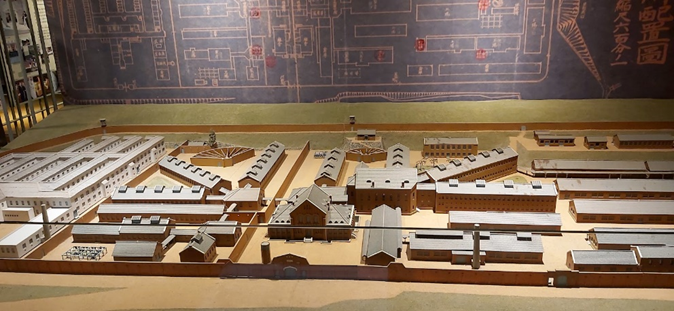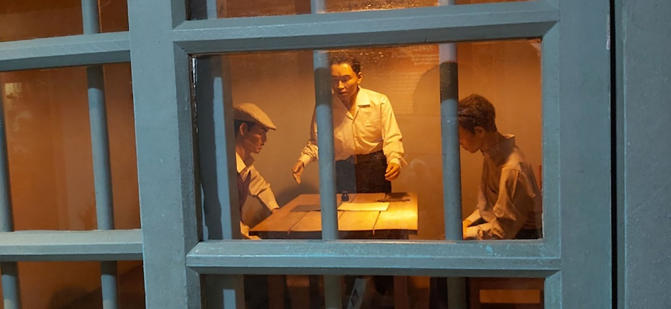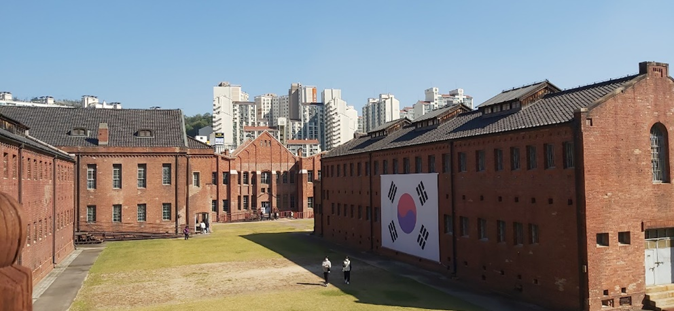- 한국어
- English
- 日本語
- 中文
- العربية
- Español
- Français
- Deutsch
- Pусский
- Tiếng Việt
- Indonesian
By Honorary Reporter Wing Tung Bonnie Lo from China
Photos = Wing Tung Bonnie Lo
Being a Hong Konger, I grew up hearing from my grandparents stories of their lives during the Japanese colonial period. Learning about Korean history in majoring in Korean studies, I developed a curiosity about Korea under Japanese colonial rule and if similarities existed between such times in Korea and Hong Kong.
When the professor who taught a class on modern Korean history spoke of Seodaemun Prison History Hall last month, I decided to visit the landmark on June 23. Set up in 1908 to detain independence activists until liberation in 1945, the prison was kept running to imprison pro-democracy activists until 1987, and was restored and opened to the public in 1998.

A model of Seodaemun Prison is available at the hall.
The site has indoor and outdoor sections. I first visited Exhibition Hall, which was originally the prison's administrative and security office. The first and second floors have exhibitions with detailed explanations on the judicial system, installation and expansion of prisons in Japanese-ruled Korea, as well as the history of this prison. I was shocked to learn how the Japanese colonial government turned Korea into a prison state by building so many such facilities across the country to imprison activists.
The basement floor of Exhibition Hall has models of the rooms in the prison such as the investigation room, where inmates received physical examinations and waited, and the interrogation room, where prisoners were subject to cruel torture. The dim lighting and models of prisoners being tortured created a scary atmosphere and gave me an idea of the excruciating pain the prisoners suffered both physically and mentally.

A model of the investigation room shows how prisoners were interrogated at the prison.
Afterwards, I visited the buildings surrounding Exhibition Hall to see where prisoners were kept. Among the most striking sights were the ink rooms, or extremely small cells with sunlight blocked out. It was heartbreaking to know that Koreans who fought for independence were locked up in this cruel environment. Several of the cells were converted into mini-exhibition rooms showing daily life at the prison such as their schedules, meals and clothing, as well as introducing famous independence activists such as Kim Ku and Yu Gwan-sun, whom I previously learned about in my class.
I gained a deeper understanding of the activists' backgrounds and stories through this trip, and visited the women's detention facility separate from the prison cluster. It was astounding to know that all Koreans, regardless of gender, fought bravely against Japanese colonial rule.

Browsing around this cluster of buildings at Seodaemun Prison History Hall concluded my visit there.
To conclude my visit, I toured the outdoor area and saw the execution building at the corner that was where inmates were put to death from the Japanese colonial period to 1987. It was shocking to see where activists sacrificed their lives for their cause. My final stop was Gyeokbyeokjang, an exercise area for inmates divided by partitions for surveillance and control. This facility is clear evidence that prisoners were deprived of privacy as they were still monitored even when exercising outdoors.
I also saw many students from elementary to high school visiting with their teachers, who explained the history of colonial rule; their students listened attentively and participated in activities. This shows the fruit of Korea's huge efforts toward national history education, something that impressed me.
Learning about this part of Korean history also made me appreciate the courage and resilience of Koreans who resisted Japanese colonial rule and fought for independence. Most importantly, this visit reminded me how precious and important peace is and how lucky I am to be living in a much better time and environment.
enny0611@korea.kr
*This article is written by a Korea.net Honorary Reporter. Our group of Honorary Reporters are from all around the world, and they share with Korea.net their love and passion for all things Korean.